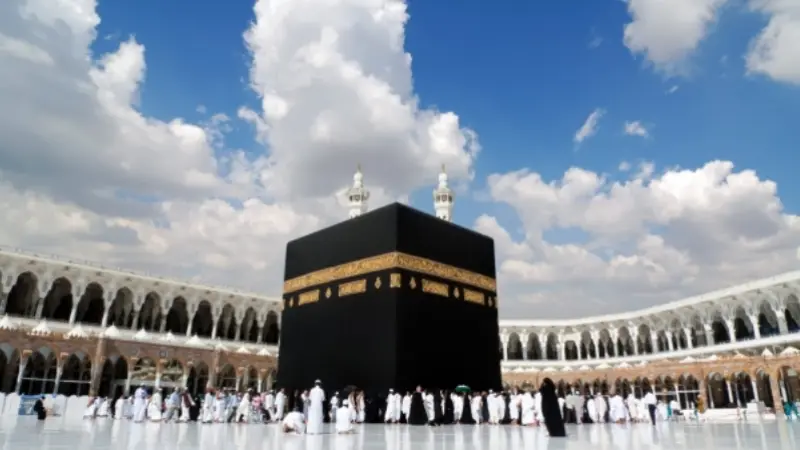The Kaaba, also known as the “House of God,” is a sacred site of immense significance in Islam. At the center of the Grand Mosque in Mecca, Saudi Arabia, it stands as an enduring symbol of unity, faith, and pilgrimage for millions of Muslims worldwide.
Year after year, the Kaaba beckons countless believers to take a spiritually fulfilling journey, embodying both the diversity of the Islamic community and the unity of its faith.
This article explores the reasons to visit the Kaaba, its location and the pilgrimage route, the best time to visit, and the must-see sights on this journey.
Why Visit
1. Spiritual Fulfilment
For Muslims, visiting the Kaaba is a spiritual commandment. It is a central part of the Hajj, one of the Five Pillars of Islam, which every adult Muslim who is physically and financially able is required to undertake at least once in their lifetime.
2. Cultural Experience
The experience of the pilgrimage also provides a unique cultural insight. The gathering at the Kaaba is one of the largest annual congregations of people in the world, reflecting a panorama of cultures, traditions, and social backgrounds.
3. Historical Significance
The Kaaba has a rich historical and religious significance dating back thousands of years. Tradition holds that the Kaaba was built by Prophet Abraham and his son, Prophet Ishmael, making it a key point of interest for those keen on ancient history and religious studies.
Location and Route
Located in the heart of the city of Mecca, Saudi Arabia, the Kaaba is nestled within the Masjid al-Haram (the Sacred Mosque), the largest mosque in the world. Pilgrims must reach Saudi Arabia, usually by air via the city of Jeddah. From there, they travel to Mecca by road, a journey of approximately 104 kilometers.
For the actual Hajj pilgrimage, the journey starts from Mecca, with pilgrims first performing a ritual called Tawaf, which involves circumambulating the Kaaba seven times. Following this, pilgrims move to the hills of Safa and Marwah, where they perform the ritual of Sa’i, walking or running between these two hills seven times.
They then travel to the plain of Arafat, approximately 20 kilometers east of central Mecca, where they engage in a day of prayer. The final stages of the Hajj take pilgrims to Mina and Muzdalifah, for further prayers and the ritual of stoning the devil, symbolizing the rejection of evil.
When to Visit
The timing of a visit to the Kaaba typically coincides with Islamic religious observances. The most significant of these is the Hajj pilgrimage, which takes place from the 8th to the 12th of Dhu al-Hijjah, the last month of the Islamic lunar calendar. The exact dates vary from year to year on the Gregorian calendar, as the Islamic calendar is 10 to 11 days shorter.
Another time when Muslims visit the Kaaba is during the Umrah, a pilgrimage that can be undertaken at any time of the year. While it is not obligatory like the Hajj, Umrah is highly recommended and also involves circumambulating the Kaaba among other rituals.
It’s important to note that due to the extremely high number of pilgrims during the Hajj period, planning and booking well in advance is crucial. The Saudi government also has specific visa requirements for those entering the country for these pilgrimages.
What to See
While the central focus of the visit is the Kaaba itself, a black, cube-shaped structure draped in a gold-embroidered black cloth, several other important religious and historical sites are part of the pilgrimage:
1. Maqam-e-Ibrahim
This is a small, gold-topped structure near the Kaaba that houses the stone on which Prophet Abraham is believed to have stood while building the Kaaba.
2. Hijr-Ismail
A semi-circular wall opposite the northwestern wall of the Kaaba. Tradition holds that it contains the graves of Prophet Ishmael and his mother, Hagar.
3. Zamzam Well
Near the Maqam-e-Ibrahim is the Zamzam well, believed to be a miraculously-generated source of water from God.
4. Mount Arafat
This is a granite hill east of central Mecca. It is here that Prophet Muhammad delivered his last sermon, and it is considered the most important location visited during the Hajj pilgrimage.
In conclusion, a visit to the Kaaba offers a unique spiritual journey that connects believers to their faith in a profound way. Whether it’s for the fulfillment of religious obligations, a cultural immersion, or a historical exploration, the trip is an unforgettable experience that resonates deeply with all who undertake it.
